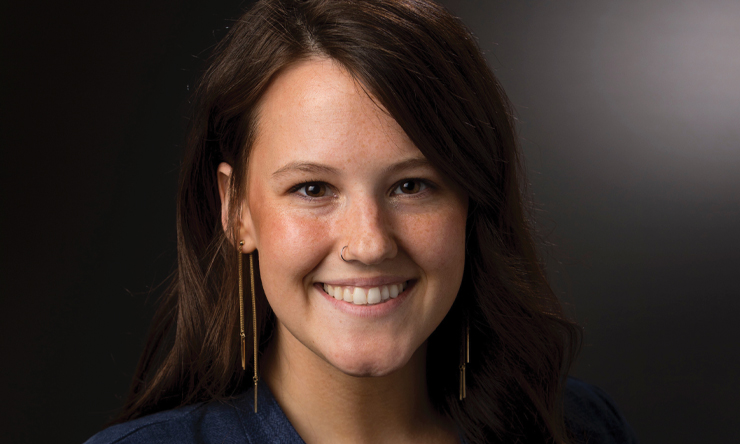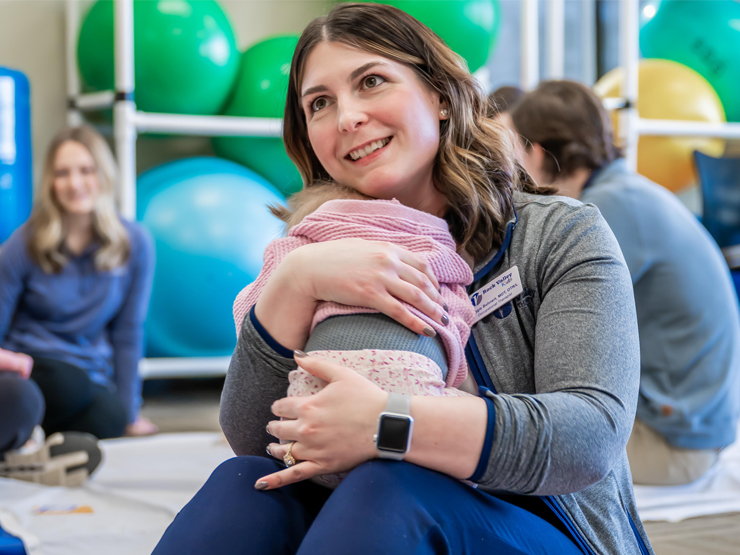Inauguration Address
Welcome to the Ambrose Table. I am grateful to welcome Bishop Zinkula and members of our board of trustees, religious leaders from the Diocese of Davenport, Muslim and Jewish communities as well as other Christian communities. I am grateful for the presence of Sr. Joan and Dr. Rogalski, previous presidents at St. Ambrose and the other college presidents and delegates representing universities across the country. As well I am pleased to welcome members of the Quad City Chamber of Commerce, the Hilltop Business Community, and a representative from Senator Charles Grassley's office. Finally, I am honored to be at the Ambrose table alongside an amazing group of faculty, staff and students as well as my own parents, siblings and their families, and my own children Peter, Isaac, Luke, Mark, Seemela, Marianna, Elijah and Zechariah.
I thank all of you for honoring St. Ambrose University and me with your attendance here today. It is humbling to stand before you as the 14th president of this university.
I do want to request a moment to introduce and thank one more individual who sets the table each day alongside me, and that is my husband of 28 years, Ken.
On an early October day nearly 30 years ago, Ken and I were driving through the Badlands National Park of South Dakota. Just a brief three weeks earlier, I had called his parents and shared with them that I thought they needed to support his calling to be a priest. Ken had spent considerable time in discernment and felt God was calling him to this vocation. We were good friends and so he, despite this decision, had still decided to travel with me.
So, half way through the park he requested that I pull over. I was driving, and I shared with him that I didn't think we had time because we were meeting other friends in Rapid City and needed to stay on track. About one mile later, he requested again that I pulled over. My snide reply was, "What, do you need to use the bathroom? We don't have time right now if we are going to make it." Then in a rather uncharacteristically stern voice he said, "I am asking that you pull over right now."
So, I pulled the car into the saddle point trailhead. Ken opened the car door and said, "Let's take a hike." I reluctantly climbed out of the vehicle and proceeded on a rather steep climb to the top of the saddle point pass. As we looked out over the top of the vista, a very poetic Ken began a series of beautiful statements culminating in a proposal of marriage. And, I didn't say "Yes." Well, I didn't say exactly "Yes," I said, "Absolutely!" He didn't have a ring and all the requisite plans, but that didn't matter. The "Absolutely" sealed our fate for what has now been 28 years of marriage.
Whether it was welcoming two adopted children from Africa to our family, working with new immigrants in Canada, helping at a homeless shelter for men, leading faith formation for young air force academy cadets, spearheading a mission trip for 40 youth and adults to Mexico and Dominica, taking bold positions on race relations or other social issues in a rural community, or welcoming thousands of students, faculty and staff to dinner at our home, we see our relationship as a ministry committed to opening ourselves to the table of possibility.
Today, I need to recognize what has been an unwavering commitment to a faith in me personally and a faith in something far greater than each of us. A faith that has led us on a powerful journey of "Absolutely." Ken has been an invaluable partner, friend, companion, father, and spouse. And for that, I want to say thank you for every "Absolutely."
Can we get everybody around the table?
I'm sure you have heard that expression. What's usually implied is can we invite the people who need to be at the meeting there to make the decisions that need to be made.
Can we get everybody around the table has had a different meaning for the Novak family. First of all, can we get the table into the house?
I'm not kidding.
When we were living in Germany, Ken and I bought what is called a monk's table, a solid oak long table that at the time met the needs our growing family. We had to bring it through a window, one of those large European windows with no screens.
When we moved back to the States, we took our measuring tape with us, set to the length of the table. If we couldn't fit the table into the house, then this wasn't the house. One real estate agent finally said in exasperation, "I've never seen anyone buy a house around a kitchen table."
We eventually bought a house, but knocked out a wall by the kitchen to get the table to fit.
Everything happens at that table.
The theme I chose for this special day is "Come to the Table" and what's behind those four words is a lot more than a sentimental invitation.
Let's start with the word "table."
This is not a random piece of furniture. This is the nerve center of a community. When I say "everything happens at the table" I mean to say we invite, we serve and we are nourished. We become vulnerable and share wisdom. We curse middle school algebra and we praise the eighth Play-Doh model of a plant cell. We pay bills and send out graduation invitations. We roll out cinnamon rolls for Christmas morning and dye eggs for Easter. We watch our teenage boys eat their fifth bowl of cereal at 10:30 p.m., and sit with a Sunday cup of coffee and the newspaper. We pray, before the meal and after. We pray when we listen. We pray when we share. We laugh. A lot. We retell the stories of our lives.
The table is not just a place to recall memories. The table is a place that establishes a proof that we live, move, and invest our whole selves in something that is continually co-created with those who sit alongside us. Something greater than ourselves.
In that spirit, I now want to ask, "What is your table?"
Your table may be the art studio bench, where you listen to a student explain her desire to co-create with the universe.
Your table may be soccer pitch, or the pitcher's mound, or the bus on the way to a cross-country meet, or the quiet space across your desk where an athlete shares with you her aspirations and challenges.
Your table may hold Bunsen burners and beakers. It might be an engineering lab or a collaborative intern work space.
Your table may be a business office filled with whiteboards and sticky notes in an attempt to solve a complex problem.
Your table may fill an auditorium bursting with the sounds of praise or the individual space of a lesson where a saxophone player learns to let go into a jazz improv he has never felt before.
Your table may be a sacred altar or the small side table inside a confessional.
Your table may be the book resting on the knees of your student, who experiences her world expanding.
Your table is where you meet others, and when two or more are gathered in that sacred space of table, God is there as well.
Friends, the table is a place of communion; of conversation, conflict, or connection. At its origin, communion implies "come" as in "come to the table." The phrase might seem forceful, as if we are ordering someone to get to the table before the food gets cold, but I like to think that the invitation "come to the table" has an urgency about it, and a sense of confidence that assures those -- who may not think that they are invited -- to join us.
Perhaps if we are honest with ourselves, we recognize that inviting a stranger to our table is difficult. It's difficult because often our table has become a place of comfort, where we invite those we know, those to whom we relate, those with whom we agree rather than one of unpredictable dialogue, co-creativity, silent reverence, or vulnerability.
Amy C. Novak
In her inaugural address on Oct. 1, 2021, Amy C. Novak, EdD invited all to join her in the meaningful work of setting a new table for the next decade of the 21st Century.
Who is around our table?
Today we are living in challenging times. But these times are not without hope.
In a time of division and polarization, it is important that the St. Ambrose table has the courage to welcome people who may not be like us, whose experience, race, gender, ethnicity, ability level, religious background, political alignment may be different from our own. Our table must be set to collectively demonstrate how inclusivity can be a source of strength rather than a wedge of division.
A diverse table may be a table of tension but also a table of great growth and opportunity. We ought not don a false mask or Pollyannic approach to "let's all get along," but instead the tables of St. Ambrose University should become comfortable wrestling with the tension of differing perspectives through a process that models civil and respectful dialogue.
Friends, let us empty ourselves of what divides us: the venom of prejudice, the fear that we are incapable of expanding our circle of care, the polarizing dichotomies that creep into our lexicon and our subsequent behaviors, and the toxic waste of incivility that continues to erode relationships. Instead, let us set an Ambrose table of human solidarity in the model of a Christ who wrapped a towel around His waist, humbled himself, poured water over the feet of all, and washed the feet even those who would persecute him.
One of the ways that I plan to work with the St. Ambrose community and our extended community is make room at our many tables for those who do not feel they can come because of cost, fear, or simply the unknown of the college process. In a time when access and affordability often represent insurmountable barriers to low-income students, first-generation students, and students of color, the St. Ambrose table must be innovative in its approach to inviting and welcoming students of all backgrounds as we strive to pilot new business models of affordability and create new pathways to ensure all students, regardless of background and respectful of personal dreams, can access higher education.
Similarly, we need to welcome business partners, religious leaders, non-profit strategists to inform the creation of a 21st century curriculum that develops leaders across their lifespan. Leaders who are prepared to respond ethically, creatively, and innovatively to the challenges that lie before us.
If we can make room in ourselves to invite all to our tables, then we must also give consideration to the menu, to the meal, to how we are to feed those who find themselves around our tables. How do we nourish each other?
In a time when cognitive science informs us that our new generation of learners have awakened our need to meet their intellectual curiosity with fresh approaches to teaching, the St. Ambrose table must demonstrate the courage to explore, experiment and implement more effective and relevant methods of teaching so as to bring out the very best in our students.
In a time when the pandemic, income inequality, global political instability, or racism flood our news feeds, the St. Ambrose table must inspire innovative, creative problem-solving inclusive of the voices most impacted by these global challenges. An Ambrose table must model approaches that transcend disciplinary silos and invite perspective from across the academic spectrum as well as community input from leaders at the grassroots level.
Beyond pedagogical approaches or even the integration of workplace realities, however, we Ambrosians must be present for those at the table. We must eschew the distraction of technology. We must pause before reacting to a brief headline stealing our attention from other important tasks. A global pandemic has brought the phrase "social distancing" to our everyday vocabulary and lifestyle. Importantly, however, the Ambrose table must model connection that is meaningful and sincere. I believe the challenge before all of us is to make our encounters with each other rich with the possibility of growth. Allowing others to dream and explore, allowing others to question and test answers, allowing others to create and start over, allowing others to sit with us, to feed us with the riches of their minds and hearts. Whether we are on a phone call, an online meeting, a classroom, a study table, a studio, field, or stage, we are present.
From our physical plant staff who "keep the heat on" in the winter, to the coaches who stoke a fire in the hearts of our athletes, to staff members who hold the hand of someone fearful, scared, and unsure of their next step, to faculty who kindle a flame of purpose in our students, we labor in cooperation with the fire of the Holy Spirit. The St. Ambrose table must be more than just a school, but a community of faith and service committed to strengthening our common humanity.
I am grateful for those who have come before me, and who have set the St. Ambrose table. This is a table where our patron saint reminded us that our neighbor is our responsibility when he wrote,
On Duties 3.7.45
We cannot possibly approve of people trying to bar foreigners from the city. They banish them at the very hour when they ought to be helping them .... Wild beasts and animals regard the food which the earth supplies as something that belongs to everyone without exception .... (trans. Davidson). [People] ought to believe that nothing concerning human life is someone else's problem.
The Ambrose table is a place where at its origins, its leaders aspired to serve new immigrants to the region and serve as a source of economic, spiritual and social mobility.
The Ambrose table is a place where students, staff, and administrators came together to create the first chapter of the NAACP at any Catholic college in America.
The Ambrose table is a place where faculty and the administration recognized the need in the 1980s and 1990s to serve adult learners for growth and opportunity across their lifespan and created innovative pathways to meet the needs of those learners.
The Ambrose table is a place where past leaders have cast a bright light of hope and opportunity against the shadows of cynicism and despair.
The Ambrose table is a place table where future collaborations with community leaders will build real-time learning opportunities for students working to address complex problems.
The Ambrose table will be a place where we are anchored in Christ, aware of our community needs, adaptive in our response to learners and business partners, and affordable and accessible for the next generation of learners.
I am praying for all of us and I would invite you to pray alongside me as we enter into the meaningful work of setting a new table for this next decade of the 21st century. As St. Ambrose reminds in Letter 73.7, ours is table where we have the courage to not fear change so that we can go on to better things (trans. C. Pasini).
May the Light of truth, healing, and transcendent purpose be the nourishment that we offer to all who gather around our table. May we open our minds and hearts to the undiscovered possibilities that lie ahead. May we welcome all whom we encounter to the Ambrose table, a place where inclusive, innovative, and invitational leaders are intentionally formed for the work of Christ in our world.
Amen.
Share This Story




